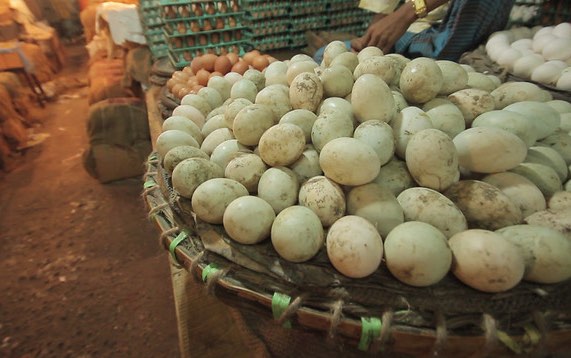Poor diets are now the No. 1 risk factor in the global burden of disease (GBD), accounting for one in five deaths globally. Too much sugar, fat, and red meat increase the risks of heart disease, diabetes, and cancer—all killers in later life (mostly in higher income countries). Too little nutrient-dense fruits, vegetables, dairy, eggs, meat, and fish are associated with wasting, stunting, and micronutrient deficiencies in early childhood—all killers in early life (mostly in lower income countries). Poor diets are therefore at the epicenter of a diverse range of health problems in a diverse range of places.
Is it possible, though, that the nature of the global food system creates different dietary problems in rich and poor countries alike? That’s the question we ask in a new paper in The Journal of Nutrition, in which we analyze consumer food prices for 657 products in 176 countries surveyed by the World Bank’s International Comparison Program (ICP).
The metric we use to analyze the global food system from a consumer perspective is the “relative caloric price” of a given food. Take eggs, for example: How expensive is an egg calorie in Niger compared to the most important staple foods in that country? Egg calories in Niger are 23.3 times as expensive as a calorie from a staple food, such as rice or corn. In contrast, egg calories in the United States are just 1.6 times as expensive as staple food calories. The interactive map below illustrates how these relative caloric prices differ across regions for various products.
These relative caloric prices have some nice properties. First, they capture the cost of dietary (caloric) diversification at a given income level. Second, this caloric calculus is consistent with the observed behavior of poor populations who seem to care a lot about purchasing cheap calories. Finally, these relative caloric prices are currency-free, allowing comparisons across countries.
Our analysis yields a striking result: As countries develop, their food systems get better at providing healthier foods cheaply, but they also get better at providing unhealthier foods cheaply. Hence the problem in less developed countries is that poor people also live in poor food systems: Nutrient-dense foods like eggs, milk, fruits and vegetables can be very expensive in these countries, making it much harder to diversify away from nutrient-sparse staple foods like rice, corn and bread. The problem in more developed countries is rather different: Unhealthy calories have simply become a very affordable option. In the U.S., for example, calories from soft drinks are just 1.9 times as expensive as staple food calories and require no preparation time.
These price patterns are consistent with the so-called nutrition transition: As countries develop, diets diversify into more nutritious foods (though sometimes slowly), but they also diversify into unhealthy foods like soft drinks. Indeed, our study shows that even after controlling for confounders like per capita income, education and urbanization, the relative caloric prices of animal-sourced foods (ASF) are positively associated with stunting in early childhood. The chart below illustrates that, generally, higher milk prices correlate with increased prevalence of stunting, while the relative prices of sugar-rich foods are negatively associated with obesity prevalence (lower sugar prices increase obesity).
What is it about the global food system and the process of economic development that delivers the wrong price of healthy and unhealthy foods in so many settings? Part of the answer lies in the foods themselves. Sugar is very dense in calories; green leafy vegetables are not. Perishability is also hugely important. Eggs and fresh milk can’t easily be traded over long distances. That means that those exceptionally high egg prices in Niger stem from the very low productivity of egg production in Niger—importing cheap eggs from the U.S. is simply not an option. For processed foods, we suspect prices are more a function of demand (is there a big enough market of junk food in Niger?) and the related ability of manufacturing sectors to cost-effectively produce processed foods (manufacturing in Africa faces many, many challenges).
While these findings should be intuitive to economists well versed in the “law of one price” (and its violations!), the fact that relative food prices differ so markedly and so systematically provides a very strong rationale for nutrition-focused food policies.
Closing the healthy food gap between rich and poor countries requires more diversified investments in agricultural R&D to improve productivity of nutrient-dense foods—an important implication for CGIAR—as well as improvements in infrastructure and the broader business environment.
The low and declining cost of unhealthy foods is a much trickier issue to grapple with: Taxes on unhealthy foods may be one solution, but the caloric cheapness of sugars and oils/fats is immense, and we suspect there might be more traction in nutrition education and supply-side regulations such as food labeling.
Yet one thing is for certain: Reducing the immense global health burden of poor diets will be a huge challenge in the 21st century, and fixing the global food system must be at the very center of efforts to meet this challenge.
Derek Headey and Harold Alderman are Senior Research Fellows with IFPRI’s Poverty, Health, and Nutrition Division. This post first appeared on the World Bank Data Blog.
This research was conducted under the Advancing Research on Nutrition and Agriculture (AReNA) project, Phase 1, supported by the Bill & Melinda Gates Foundation and the CGIAR Program on Agriculture for Nutrition and Health (A4NH).







